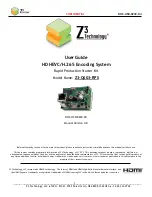
76
Circuit Descriptions
TM8100 Mobile Radio
Service Manual
May 2004 © Tait Electronics Limited
Operation in
Emergency Mode
If the radio is off when the emergency mode is activated, the radio is
powered up but the display on the control head is not switched on. If
the radio is on when the mode is activated, the display is frozen. In the
latter case, if the
ON
/
OFF
key is pressed, the display is switched off but the
radio remains in the emergency mode. While in this mode the radio
cycles between transmit and receive. To exit the emergency mode the
ON
/
OFF
key needs to be pressed again.
3.8
Interface Circuitry
Bi-directional Lines
Bi-directional lines are provided on four pins of the auxiliary connector,
(
AUX
GPIO
4
to
AUX
GPIO
7
) one on the control-head connector (
CH GPIO
1
),
and seven on the internal options connector (
IOP
GPIO
1
to
IOP GPIO
7
).
Those on the auxiliary and control-head connectors are formed by
combining two uni-directional lines. For example, the line
AUX
GPIO
4
at
pin 10 of the auxiliary connector is formed from
ITF AUX GPI
4
and
DIG
AUX
GPO
4
. The circuitry is the same in all five cases and is explained below
for the case of
AUX
GPIO
4
.
Output Signals
An output on the line
AUX
GPIO
4
originates as the 3.3 V signal
DIG AUX GPO
4
from the digital section. The signal is first inverted by Q703
(pins 3 to 5) and the output divided down to 1.6 V by R746 and R753
to drive the base of Q703 (pins 1, 2 and 6). When the latter’s collector
current is low, the base current is a maximum and creates a small voltage
drop across R761, causing the collector emitter to saturate. As the
collector current increases, the base current decreases proportionally
until the voltage across R761 reaches 1 V. At this point the base-emitter
begins to turn off and the base current diminishes rapidly. The net effect
is a current-limiting action. The current limit value is approximately
18 mA (the inverse of the value of R761). The output configuration is
open-collector with a pull-up to 3.3 V by default. Pull-up options to
5 V and 13.8 V are also available.
Five-volt Regulator
The 5 V supply mentioned above is provided by a simple buffered zener
regulator formed by Q702, D721, R721 and R722. The resistor R722
limits the current to about 25 mA under short-circuit conditions.
Input Signals
(
AUX
GPIO
4
)
An input signal applied to
AUX
GPIO
4
is coupled via R757 to
ITF
AUX
GPI
4
and fed to the digital section. As the input signal may exceed the
maximum allowed by the digital section, it is clamped by D711 and a
shunt regulator. The shunt regulator consists of Q708, R719 and R720
and begins to turn on at approximately 2.7 V. In combination with
D711, the input to
ITF
AUX
GPI
4
is therefore clamped to 3.3 V nominally.
The value of R757 is made large to minimise the loading effect on the
output pull-up resistors. On
AUX
GPIO
4
only, the optional MOSFET
Q707, which has a high current drive, may be fitted.
Содержание TM8000 Series
Страница 32: ...32 Introduction TM8100 Mobile Radio Service Manual May 2004 Tait Electronics Limited ...
Страница 78: ...78 Circuit Descriptions TM8100 Mobile Radio Service Manual May 2004 Tait Electronics Limited ...
Страница 106: ...106 General Information TM8100 Mobile Radio Service Manual May 2004 Tait Electronics Limited ...
Страница 124: ...124 Servicing Procedure TM8100 Mobile Radio Service Manual May 2004 Tait Electronics Limited ...
Страница 164: ...164 Servicing of Control Head TM8100 Mobile Radio Service Manual May 2004 Tait Electronics Limited ...















































